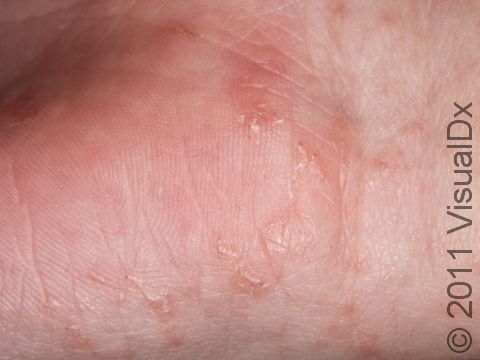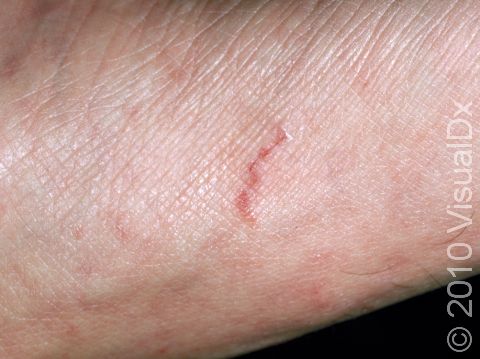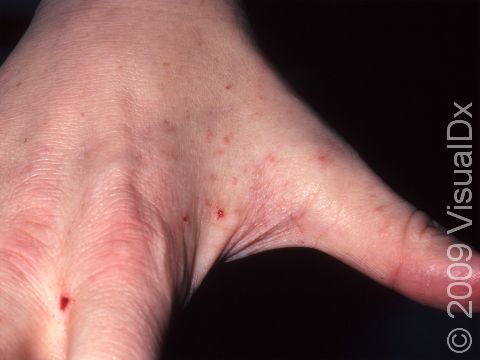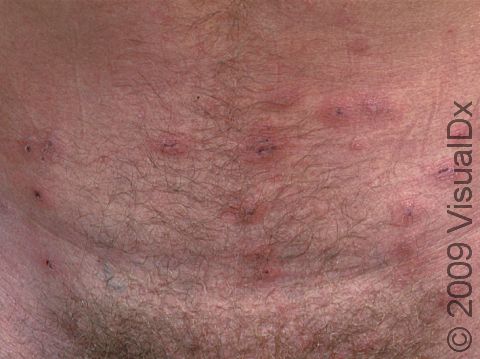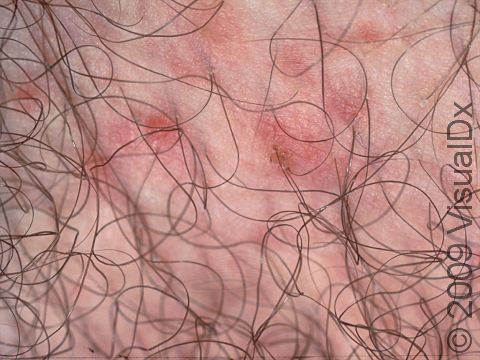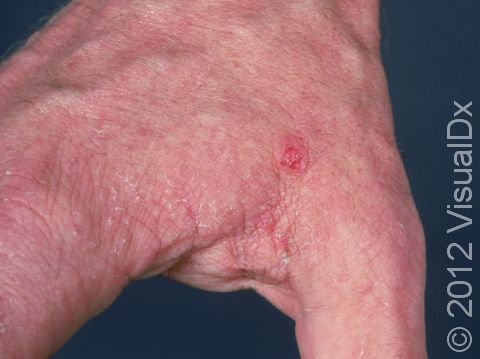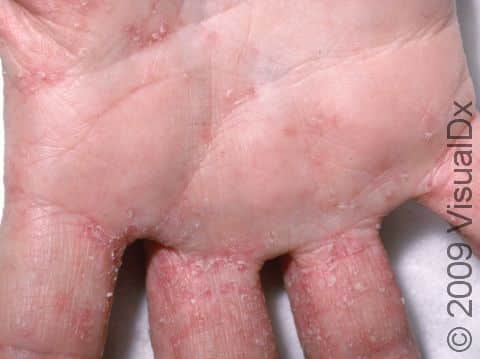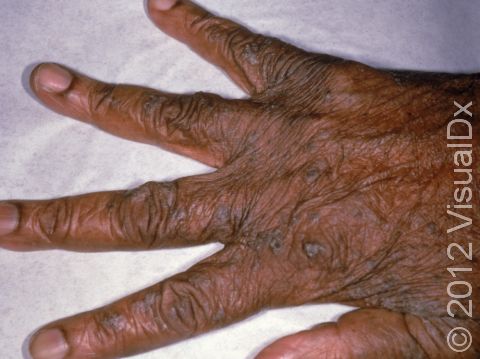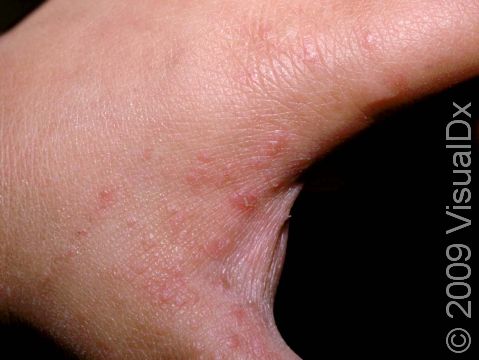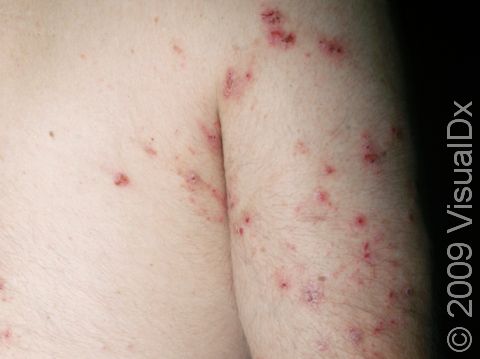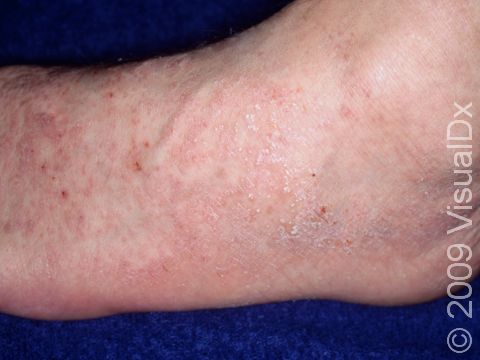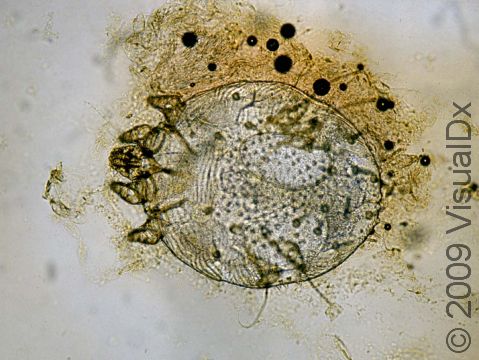Scabies
Scabies is an infestation of the skin caused by a tiny mite called Sarcoptes scabiei var. hominis. Scabies is very contagious and spreads rapidly in crowded areas such as hospitals, nursing homes, child care facilities, prisons, and other locations where people spend extended periods of time in close contact with one another.
The rash of scabies is extremely itchy and develops when a pregnant female mite burrows into the skin and lays her eggs. The human immune system is very sensitive to the presence of the mite and produces an allergic response that causes intense itching. Although a person who is infested with scabies usually only has 10–20 mites on his or her entire body, there may be a large number of lesions because of this allergic response. Without treatment, the condition will not usually improve.
Who's At Risk?
Scabies is seen in people of all ethnicities, all ages, both sexes, and at all socioeconomic levels. The infestation is not caused by lack of personal hygiene but is more frequently seen in people who live in crowded, urban conditions. People at particular risk are those who are in crowded living situations, such as hospitals, nursing homes, and prisons. Though scabies is extremely contagious, it usually requires prolonged skin-to-skin contact with a person who is already infested. Limited contact, such as a hug or handshake, will not normally spread the infection. However, scabies is easily spread to sexual partners and to other members of the household. Even if a person does not yet have symptoms, he or she can pass the infestation on to other people. Less commonly, it may be spread by sharing towels, clothing, or bedding.
Signs & Symptoms
Although the entire body may itch, the most common locations for the lesions of scabies include:
- The areas between the fingers (finger webs)
- Inner wrists, inner elbows, and armpits
- Breasts of females and genitalia of males
- Navel (umbilicus)
- Lower abdomen
- Buttocks
- Backs of knees
Although in adults it is rare to see lesions on the face, scalp, and neck, these areas are commonly affected in children aged younger than 2 years.
The most obvious signs of scabies are pink-to-red bumps, which can look like pimples or bug bites, sometimes with scale or a scab on them. However, the tell-tale lesion of scabies is the burrow, which is small and often difficult to see. Typically, a burrow appears as a small, thread-like, scaly line (3–10 mm long), sometimes with a tiny black speck (the burrowing mite) at one end. The adult mite is about 0.3 mm long and is very difficult to see. Scabies mites crawl; they do not jump or fly.
People who are exposed to scabies may not develop itchy lesions for up to 6 weeks after becoming infested, as the immune system takes some time to develop an allergic response to the mites. However, individuals who have had scabies before may develop the rash within several days of re-exposure.
Scabies is intensely itchy, especially at night. Excessive scratching of the itchy lesions can create breaks in the skin, which may then become infected with bacteria.
A severe form of scabies, called Norwegian scabies or crusted scabies, is seen in:
- Elderly people
- Individuals with weakened immune systems (such as organ transplant recipients or people with HIV/AIDS)
- Malnourished people
- People who are physically and/or mentally impaired or disabled
In people with Norwegian/crusted scabies, the skin is covered with thick, white scales and crusts. The lesions are widespread, appearing over the scalp, face, elbows, knees, palms, and soles of the feet. Interestingly, these infestations may not be itchy, although the lesions may contain up to two million mites.
Self-Care Guidelines
Scabies requires prescription medication in order to stop the infestation. Once you are under a doctor’s care, there are steps you can take to prevent scabies from coming back:
- Mites cannot survive off the human body for more than 48–72 hours. Therefore, wash all clothing, bedding, and towels used by the infested person in the past 72 hours in hot water, and dry these items in a hot dryer.
- Vacuum all carpets, rugs, and furniture, and discard the vacuum bags.
- Put anything that cannot be laundered into plastic bags for at least 72 hours.
- Pets do not need to be treated because the mite only lives on humans.
You can return to work or school the day after treatment is started.
Treatments
Your physician may be able to diagnose scabies simply by examining your skin for typical lesions, such as burrows. Your doctor may also diagnose scabies by gently scraping some skin onto a slide and looking with a microscope for mites, eggs, or mite feces.
In most cases of scabies, your doctor will prescribe a medicated cream or lotion to kill the infestation, such as:
- Permethrin 5% cream (Elimite®) – This is the first choice for treatment because it is very effective and safe. It is safe even for children and pregnant women. Rinse the cream off after 8–14 hours, and repeat in 7 days to kill recently hatched larvae.
- Crotamiton 10% lotion or cream (Eurax®, Crotan®) – This is not as effective as permethrin and can be irritating to the skin. Apply once daily for 5 consecutive days.
- Precipitated sulfur (5% or 10%) – This is prepared with petroleum jelly and is applied nightly for 3 consecutive nights. This is often the best choice for children aged younger than 2 years and for pregnant and lactating women because it is very safe to use. Unfortunately, it is greasy, has an odor, and can stain clothing.
- Lindane 1% solution – Lindane can be toxic to the nervous system. Therefore, avoid using it for young children and infants, pregnant or lactating women, and people with diseases affecting the nerves (neurological diseases). Apply to the body, rinse in 8 hours, and repeat in 7 days.
When using a topical cream, lotion, or ointment, be sure to follow these steps (unless your physician gives other instructions):
- For adults, apply to the entire body except for the face and scalp.
- For children, apply to the entire body, including the face and scalp, as these areas are commonly infested.
- Smear the product beneath the fingernails and toenails.
- Apply to body folds, including inside the navel, in the buttocks crease, and between the fingers and toes.
In more severe cases of scabies, your doctor may prescribe oral medications:
- Ivermectin (Stromectol®) pills – Take once and then repeat 1–2 weeks later. Do not give to children aged younger than 5 years or who weigh less than 15 kg (about 35 lb), or pregnant or lactating women.
- Antibiotic, if any scratched areas appear to be infected with bacteria.
After treatment, the rash and itching may take up to 4 weeks to go away, as your immune system continues to react to the dead mites. However, new burrows and rashes should stop appearing 48 hours after effective treatment. If you see new burrows or bumps, or if the itch continues for more than 4 weeks, you may need to be treated again.
Your doctor may also recommend steroid creams or antihistamine pills to relieve the itching. In severe cases, oral steroids may be required to decrease symptoms.
Because it may take up to 6 weeks after exposure to develop symptoms, people may be unaware that they are infested. Therefore, household members, sexual partners, and anyone else with prolonged skin-to-skin contact with an infested person should also be treated. Ideally, everyone should be treated at the same time in order to prevent reinfestation.
Visit Urgency
See your doctor if you develop an extremely itchy rash that does not go away. If other members of your household or people with whom you are in close contact have similar itchy rashes, they should also be evaluated by a physician.
References
e Control and Prevention. Scabies. http://www.cdc.gov/scabies/index.html. Modified November 10, 2008. Accessed March 11, 2009.
Bolognia, Jean L., ed. Dermatology, pp.1321-1324. New York: Mosby, 2003.
Freedberg, Irwin M., ed. Fitzpatrick’s Dermatology in General Medicine. 6th ed. pp.1374, 1394, 2283-2284. New York: McGraw-Hill, 2003.
Last modified on October 11th, 2022 at 2:44 pm

Not sure what to look for?
Try our new Rash and Skin Condition Finder
